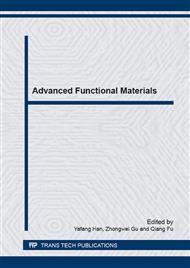[1]
P. Zambezi, M. Hale, J.H.L. Voncken, Bastnäsite-(Ce) at the Nkombwa Hill carbonatite complex, Isoka District, Northeast Zambia, Mineralogy and Petrology. 59(1997) 239-250.
DOI: 10.1007/bf01161861
Google Scholar
[2]
R. Chi, Z. Li, C. Peng, Preparation of enriched cerium oxide from bastnasite with hydrochloric acid by two-step leaching, Metallurgical and Materials Transactions B. 37(2006) 155-160.
DOI: 10.1007/bf02693144
Google Scholar
[3]
X.W. Huang, Z.Q. Long, H.W. Li, Development of rare earth hydrometallurgy technology in China, Journal of Rare Earths. 23(2005) 1-4.
Google Scholar
[4]
R. Chi, Z. Xu, A solution chemistry approach to the study of rare earth element precipitation by oxalic acid, Metallurgical and Materials Transactions B. 30(1999) 189-195.
DOI: 10.1007/s11663-999-0047-0
Google Scholar
[5]
M. Li, Z. Liu, H. Li, Effects of the synthesis methods on the physicochemical properties of cerium dioxide powder, Colloids and Surfaces A: Physicochemical and Engineering Aspects. 301(2007) 153-157.
DOI: 10.1016/j.colsurfa.2006.12.042
Google Scholar
[6]
L. Qian, J. Zhu, W. Du, X. Qian, Solvothermal synthesis, electrochemical and photocatalytic properties of monodispersed CeO2 nanocubes, Mater Chem Phys. 115(2009) 835-840.
DOI: 10.1016/j.matchemphys.2009.02.047
Google Scholar
[7]
T. Hoshino, Y. Kurata, Y. Terasaki, Mechanism of polishing of SiO2 films by CeO2 particles, Journal of Non-Crystalline Solids. 283(2001) 129-136.
DOI: 10.1016/s0022-3093(01)00364-7
Google Scholar
[8]
L. Wang, K. Zhang, Z. Song, Ceria concentration effect on chemical mechanical polishing of optical glass, Applied surface science. 253(2007) 4951-4954.
DOI: 10.1016/j.apsusc.2006.10.074
Google Scholar
[9]
N.K. Renuka, Structural characteristics of quantum-size ceria nano particles synthesized via simple ammonia precipitation, Journal of Alloys and Compounds. 513(2012) 230-235.
DOI: 10.1016/j.jallcom.2011.10.027
Google Scholar
[10]
H.W. He, X.Q. Wu, W. Ren, P. Shi, X. Yao, Z.T. Song, Synthesis of crystalline cerium dioxide hydrosol by a sol-gel Method, Ceramic International. 38(2012) 501-504.
DOI: 10.1016/j.ceramint.2011.05.063
Google Scholar
[11]
T.P. Yadav, O.N. Rivastava, Synthesis of nanocrystalline cerium oxide by high energy ball milling, Ceramic International. 38(2012) 5783-5789.
DOI: 10.1016/j.ceramint.2012.04.025
Google Scholar
[12]
S. Chowdhury, M. Yasir, M.A.B. Bustam, Hydrothermal Synthesis and Characterization of One-dimensional Ceria Nanorod for Chromium Ion Removal from Wastewater, Journal of Energy Technologies and Policy. 3(2013) 489-494.
Google Scholar
[13]
H. Balavi, S. Samadanian-Isfahani, M. Mehrabani-Zeinabad, Preparation and optimization of CeO2 nanoparticles and its application in photocatalytic degradation of Reactive Orange 16 dye, Powder Technology. 249(2013) 549-555.
DOI: 10.1016/j.powtec.2013.09.021
Google Scholar


